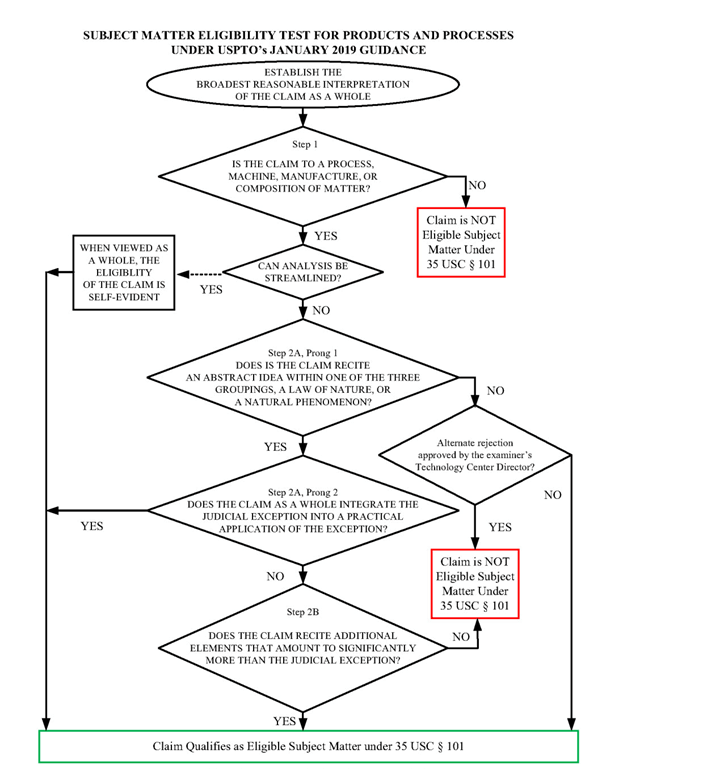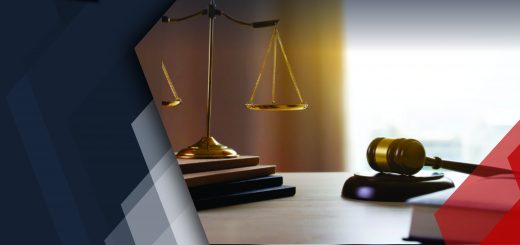Overcoming 35 USC 101 Rejections in View of Recent USPTO Guidelines and Examples
A claimed invention must fulfill the requirements of 35 USC § 101 for becoming patent-eligible at the US Patent and Trademark Office (USPTO). 35 USC 101 is typically a subject matter eligibility test for the claimed invention. Therefore, the claim set might invoke 101 rejections if not drafted properly. Moreover, once the claim set is rejected under 35 USC 101 in an office action (OA), it might get rejected again under § 101 in the subsequent OA if the applicant does not persuasively present amendment and argument.
In this article, we will discuss the requirements under 35 USC § 101, guidelines and examples issued by the USPTO, effective way to present claim amendments and arguments, and more.
Table of Contents
Requirements Under § 101
There are two steps to determine subject matter eligibility for the claimed invention under § 101.
Under Step 1, the claimed invention must fall into one of four statutory categories of innovation. The four statutory categories of the invention are process, machine, manufacture, and composition of matter.
Under Step 2, the claimed invention must not be directed to a judicial exception. By definition, a judicial exception refers to a grouping of abstract ideas, laws of nature, and natural phenomena. A claim set that is mainly directed to mathematical relationships, mental processes, or specific methods of organizing human activity comes under the groupings of abstract ideas.
Step 2 is further bifurcated in Step 2A and Step 2B. According to Step 2A, the claim set should not recite any judicial exceptions. If the claimed invention fails to satisfy Step 2A, the claim set would be examined for Step 2B. Under Step 2B, the claim set is examined to have any additional element that amounts to significantly more than the judicial exception.
Now that we have understood the requirements of 35 USC 101, let us cover its guidelines and related examples that have been issued under the recent guidelines.
USPTO Guidelines for § 101 and Examples Issued
In 2014, the USPTO issued § 101 eligibility guidelines for examining a patent application for compliance with § 101 requirements. The revised guidelines of patent subject matter eligibility were published in 2019. A two-prong test was introduced to examine whether the claim set is patent-eligible under Step 2A (shown in Figure 1 below). In addition, the newly added criteria requires the claim set to have additional elements that integrate the judicial exception into practical application (if the claim set recites the abstract idea).

In conjunction with the 2014 guidelines, the USPTO released a document setting forth examples 1-36. Further, in conjunction with the 2019 guidelines, the USPTO released examples 37-42 on January 7, 2019, and examples 43-46 on October 17, 2019. These examples are hypothetical claims and overviews of the invention in different fields that focus on the ideas of eligible patent matter and patent-ineligible matter under § 101.
Even with laid out guidelines, there are differences between the claim’s interpretation by the examiner and the applicant. Usually, the applicant resorts to the traditional mode of argument to oppose the rejection. Let us understand the conventional approach that is used for § 101 arguments.
Conventional Approach for § 101 Arguments
Generally, the applicant follows the conventional approach to counter the 101 rejection. Some of the traditional approaches for 101 arguments are as follows:
- Argue 101 rejections based on some traditional case laws like “Elec. Power Group, LLC v. Alstom SA,” “DDR Holdings v. Hotels,” “Enfish, L.L.C. v. Microsoft Corp.,” “Example 3 issued in conjunction with the 2014 Interim Guidance on Subject Matter Eligibility (2014 IEG),” etc., irrespective of the field of invention and features of the claim set.
- Present a brief argument without mentioning steps or prongs.
- Amend claims to counter prior art rejection and avoid the claim amendments for 101 rejections.
However, such a conventional approach is not fail-safe. The examiner might reject the claim set again due to lack of persuasive arguments against the 101 rejection. This will burden the patent applicant to file the response again. In addition, if the OA is final, then the owner has to bear the cost of the subsequent OA. Therefore, the applicant has to ensure the citation of appropriate case laws or examples to overcome the 101 rejection.
The applicant must present a robust claim amendment by adhering to the recent USPTO guidelines and examples to avoid such a scenario. The next section discusses an effective way to present claim amendments and arguments as per the latest guidelines.
Presenting Claim Amendments & Arguments As Per Recent USPTO Guidelines and Examples
- Properly check the field of invention and features of claims.
- Find the relevance between the claimed invention and the examples released by the USPTO.
- Amend the claimed invention by adding features from the specification, if required, in view of the relevant examples.
- Argue the features of the claim set which are similar to the USPTO examples by citing the relevant examples.
- Present an argument for each of Step 1, Step 2A (Prong 1 and Prong 2), and Step 2B with different features of the claim according to the requirement of each step.
By following the steps mentioned above, the applicant can ensure overcoming 101 rejections and save cost and time.
Conclusion
It is common for patent applications to face 101 rejections during prosecution, despite drafting the claims carefully. An applicant must read the invention from a technical viewpoint to search for features that can help overcome 101 contradictions. Besides having technical knowledge, the applicant should also possess proper knowledge of the USPTO examples and case laws to use them effectively. It is crucial to hire the capabilities of a reliable third-party service provider to save valuable time and resources.
Sagacious IP is a name synonymous with high-quality IP solutions. Over the last decade, the company has been consistent in its approach to fulfilling clients’ expectations. Sagacious IP’s Office Action Response service is designed to help clients overcome 101 rejections raised by an examiner. Our team has extensive experience in responding to 101 rejections in different fields and can help you navigate through the application process with ease.
– Bhawana (ICT Drafting & Prosecution) and the Editorial Team
Having Queries? Contact Us Now!
"*" indicates required fields




